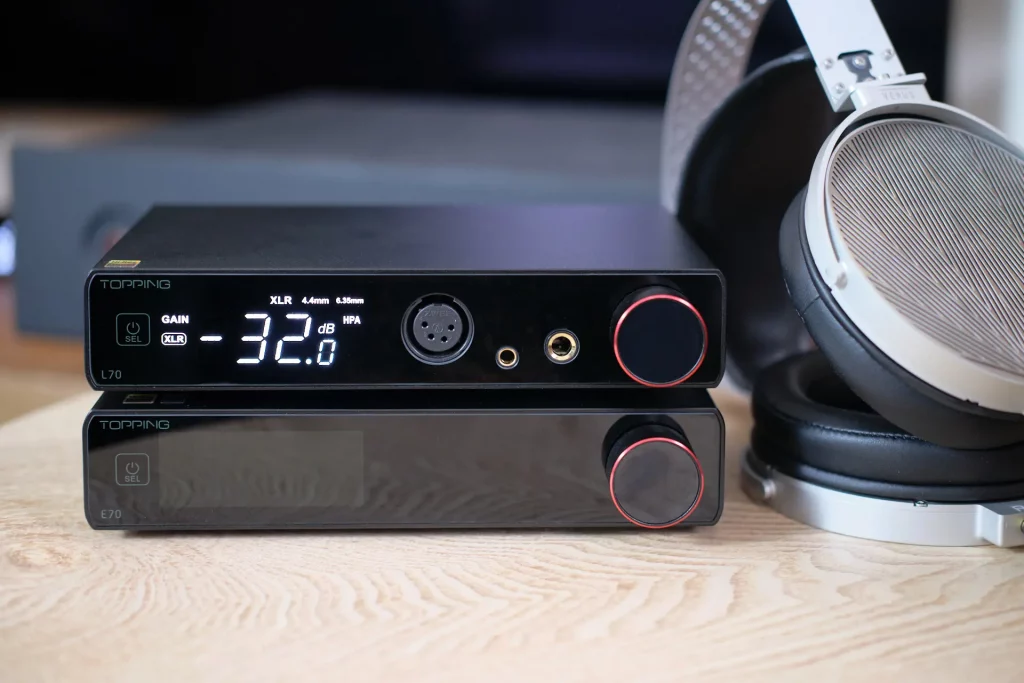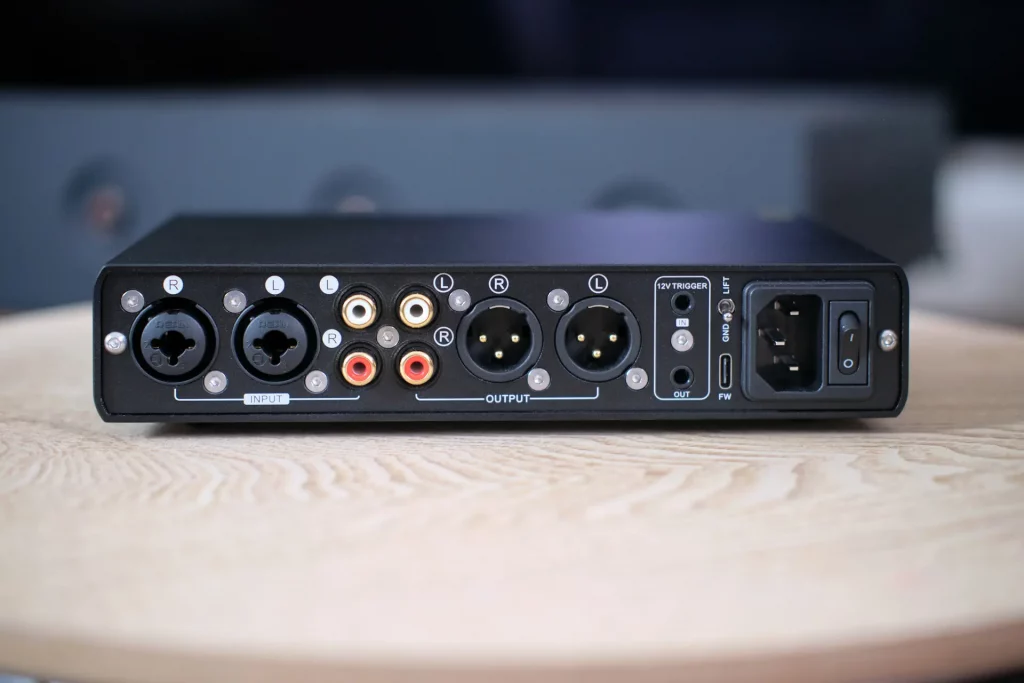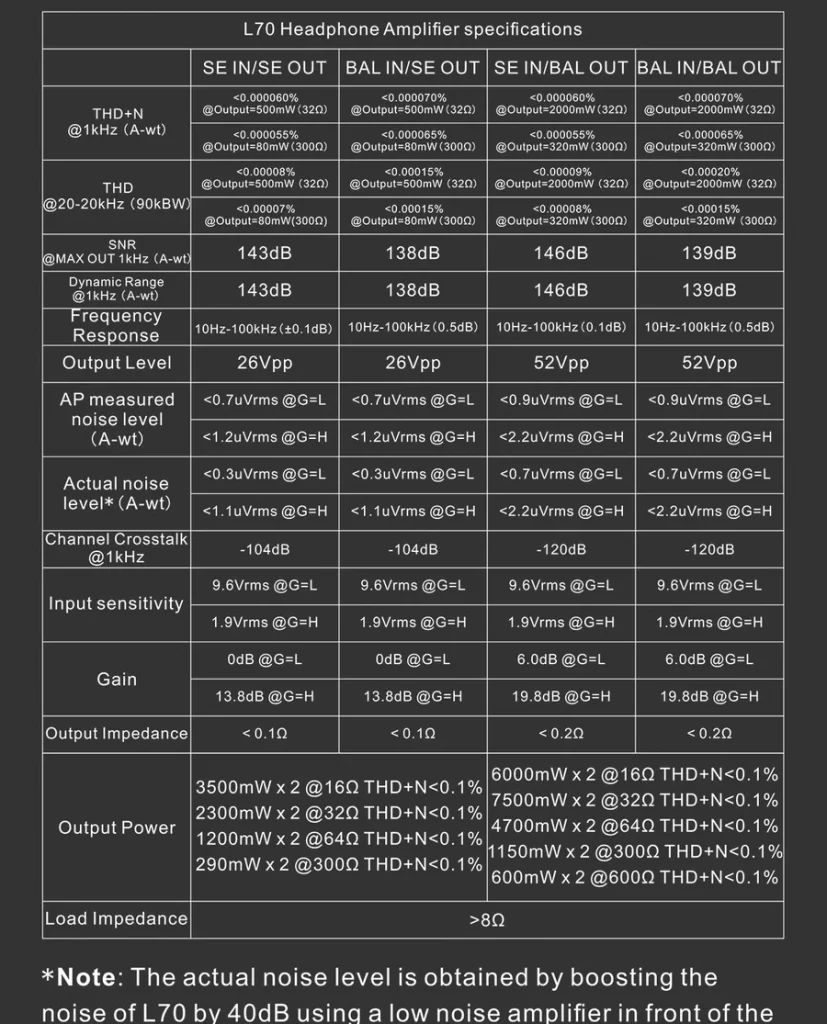Topping L70 is the top headphone amplifier of the brand’s L series but it sits firmly in the middle of the whole Topping’s offer. In my experience, that is an excellent place to be if you’re looking for a really good price-to-performance ratio.
Build and Connectivity
Topping L70’s design is meant to mate well with the E70 DAC, and it does. Both Amp and DAC follow the design language of their predecessors E30, L30, E50, and L50. This means that most of the device is wrapped inside an aluminum casing that comes in either black or silver. The front panel is always black and made out of scratch-resistant glass. You control it using a touch-sensitive button on the left and a volume knob that doubles as a button on the right. In between there is an informative OLED screen and three different ways to connect your headphones: 6.35mm, 4.4mm, and XLR. Noteworthy here is that both 4.4mm and XLR outs are fully balanced designs.


In the back, we can find two sets of inputs, an RCA single-ended and a combined TRS and XLR balanced connectors. In the output section, we again see RCA and XLR connections. Both of these are variable, meaning that you can use L70 as a very simple preamp. The unit is powered directly from the mains AC so there is no external power brick in this case.
Tech Inside
Once again, Topping utilized NFCA circuitry already known for its high power and low distortion. Topping brags about extremely high power output that goes all the way up to 2 x 7500 mW in its peak. Paired with high voltages of up to 52 Vpp, and currents up to 1.4A, this amp will drive almost any headphones on the market without a fuss, from small and sensitive IEMs to big and voltage-hungry high-impedance headphones. Distortion and noise measurements are next to perfect as with most Topping products, but as usual, I’ll not be focusing on these numbers but on the real sound quality and worth of this product. For tech spec lovers, there’s a long spec sheet at the end of the review waiting for you.
Sound
Topping L70 sounds warmer than your usual Topping device. This starts from the bassline that packs plenty of weight. Middbass section continues that with fullness and warmth. This lends a pleasant warmth to the midrange and upper frequencies too, and I don’t think that anyone would call L70 cold or analytical sounding. Don’t get me wrong, detail retrieval is very good still. I didn’t find this amplifier hiding fine details and tone textures from me. All was there but simply laid out in a warmer and softer manner, making L70 less of a monitoring tool and more of a music-enjoying device.
Voices and leading instruments are put forward, close to you, and feel quite palpable in space. Layering is done well but if you’re looking for a particularly wide and deep soundstage, L70 may fall somewhat short. To put it simply – the soundstage is decent but not spectacular.
I’m glad to say that all those watts are put to good use because the dynamics are strong. There is a good sense of scale and grunt when needed, but once again L70 shows its softer approach to creating sound and it will never sound like an unrefined brute. Refinement was something that eluded many Topping models before and I am happy that they’re getting it right lately.
Finally, you simply don’t have to worry about the pairing. Topping L70 will happily drive anything from voltage-demanding dynamic headphones, through current demanding planners, all the way to very sensitive IEMs. With the latest ones, I couldn’t notice even a hint of the background hiss that plagues some amp-IEM combinations.
Comparisons
Topping A30 Pro is an older model that used to cost the same when it was launched. In a typical Topping fashion, it’s also a powerhouse. But these two amps do sound slightly different. A30 Pro has a more laid-back midrange with thinner vocals that are further away from you. L70 sounds fuller and warmer in the midrange, all tones feel fuller and the vocals are bigger and closer. This also means that the A30 Pro develops a slightly more spacious soundstage. If you follow my reviews from time to time, you probably know that I like full-bodied sound so I tend to lean towards L70 in this case. With that said, I wouldn’t dare to recommend it easily over A30 Pro unless I know you share my taste. So my objective conclusion would be that these are equally capable amps with different tonality.
Topping A90D is the more expansive amp from the Topping’s range but is it worth it? Well, L70 doesn’t look and less capable on paper but in reality these two sound quite different. For starters, the L70 is fuller and warmer sounding. That of course means that A90D is leaner, but it also has more kick and grip in the bassline. A90D sounds more precise and reveals more details and more inner tone texture. It also creates a bigger and airier soundstage. L70 in a direct comparison is not as authoritative, not as open and clean. It simply can’t match A90D which is a better amp of the two.
Conclusion
Topping L70 is a capable and well-built product that can stand tall against any amp of a similar price. It doesn’t truly surpass the bar that was already set high by the A30 Pro. Instead, it offers a different approach to how it renders music that you may prefer, like I did.







